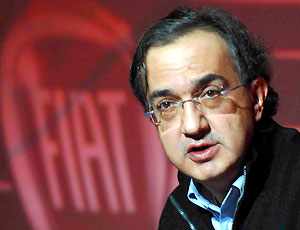 Fiat CEO Sergio Marchionne is credited with restoring profitability to Fiat’s automotive division in 2006, two years after he joined the 110-year old company. Now he has his sights set higher. Much, much higher.
Fiat CEO Sergio Marchionne is credited with restoring profitability to Fiat’s automotive division in 2006, two years after he joined the 110-year old company. Now he has his sights set higher. Much, much higher.
Marchionne now wants to create an international car company comprised of GM’s Opel, the smoldering remains of Chrysler, and the core automobile business of Fiat. Having already inked a deal to partner with Chrysler, Marchionne has taken his argument to Berlin, asking the German political leaders for permission to absorb Opel. Throw in Saab (in the mix but still for sale), Ferrari and Maserati, and it adds up to what would be the largest automobile manufacturer in Europe.
The plan actually makes sense. Of course, the merger would require blending three very different corporate mentalities, as well as their union members who will undoubtedly be concerned about benefits and job loss. It would require approval from the US bankruptcy court. It would require managing product overlap, a problem largely relegated to markets outside North America where Opels and Fiats are more prevalent.
The end result, however, may be worth the effort. Chrysler would give Fiat an entrée to the US market, an idea that already has traction. Though Chrysler’s R&D groups already have great talent, adding some international flare in the form of German engineering and Italian design cannot be bad. Indeed, the large-bodied Chrysler and Dodge cars are certainly better for their Daimler-Benz-derived hidden bits. Chrysler’s survival depends in no meager part on small, fuel-sipping cars, something its current lineup lacks but something Fiat and Opel are good at producing. It also depends on a clear vision of a path forward.
Wild-ass guesses at future North American-market products boggle the mind. Remember the American V8-powered Italian beauties from days gone by, such as the Bizzarini Strada, the De Tomaso Mangusta, and the Iso Grifo? Picture the modern-day equivalent, such as production versions of the Dodge Demon or Copperhead concepts with high-winding Abarth-tuned motors or modern diesel powerplants. A Fiat 500 or Opel Insignia (especially the Sports Tourer) with pretty much any powerplant would be welcome in Chrysler showrooms.
There isn’t much say regarding the future of other Chrysler lines, such as Jeep. The Dodge Viper, badged a Chrysler in other markets, may survive if the brand doesn’t get slurped up by Saleen, Inc.
Marchionne has said in the past that for any major carmaker to stand on its own, yearly production must exceed 5 million units. Which is a lot of cars. Fiat has release a statement saying his new company would have annual revenues exceeding 80 billion euros ($124 billion CDN). Which is a lot of money. Manufacturing, engineering, and supply synergies alone would add up to more than a billion ($1.6 billion CDN) in savings per year, according to Marchionne. Which is less money, but still a good chunk.
Marchionne’s deal has a 30-day deadline. So, is he nuts? Could be. This and plenty of other questions are piling up. But sanity notwithstanding, this is a fresh idea that bears notice. If Marchionne succeeds he will be lauded as a visionary. If it all falls apart, well, he wouldn’t be the first delusional crackpot aiming for world domination.
[ CNBC ]

